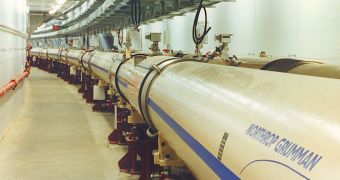It may be that a team of physicists operating the Relativistic Heavy Ion Collider (RHIC), in New York, may have broken a rule of physics in one of their experiments. If validated, the assumption would carry considerable implications for some of the most fundamental theories underlying the way our understanding of science is set up. The RHIC is based at the US Department of Energy's (DOE) Brookhaven National Laboratory (BNL), in Long Island, ScienceDaily reports.
One of the most “sacred” laws of nature says that for each action, there must be an equal and opposite reaction. This trait of all things, called parity, appears to have been broken for a very short instant in one of the experiments conducted at the RHIC, where gold nuclei are collided head-on. They are first accelerated through a 4-kilometer-long tunnel, in opposite directions. Some 1,740 superconducting niobium-titanium magnets accelerate protons to relativistic speeds, after which time they are rammed against each other. This was the most powerful machine of its class in the world until the Large Hadron Collider (LHC) was started in Europe.
In the new experiments, it would appear that the machine produced what physicists refer to as symmetry-breaking bubble of space, in which parity no longer applies. This is a major feat, because the entire Universe was until now believed to be adhering to this fundamental trait. In other words, physicists have always believed that the Cosmos is neither left-, nor right-handed, and that the laws of nature would apply regardless of whether the coordinates in which they function are inverted or not. One of the forces in the Universe that was discovered to be breaking the parity law is the weak nuclear force, which is directly responsive for radioactivity. But the strong nuclear force, another of the four standard forces in the Standard Model, was believed to hold in normal conditions.
The strong nuclear force keeps elementary particles together within the nuclei of atoms. The team of particle physicists, including the Yale University Donner Professor of Physics Jack Sandweiss, who made the recent discovery, has been working on colliding gold nuclei here for about a decade. Earlier this year, the experts managed to produce what is known as quark-gluon plasma, as we were also telling you at the time. The gargantuan magnetic field that was produced back then hinted that parity might have been broken.
“A very interesting thing happened in these extreme conditions. Parity violation is very difficult to detect, but the magnetic field in conjunction with parity violation gave rise to a secondary effect that we could detect. I think it's a real effect, but we'll know more in the upcoming years. I'd really like to see this evolve and find out exactly what's going on,” Sandweiss explains.

 14 DAY TRIAL //
14 DAY TRIAL //